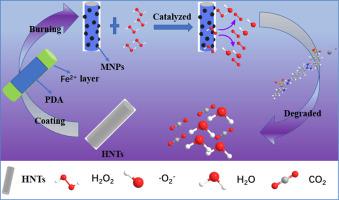当前位置:
X-MOL 学术
›
Appl. Clay. Sci.
›
论文详情
Our official English website, www.x-mol.net, welcomes your
feedback! (Note: you will need to create a separate account there.)
Mussel-inspired fabrication of halloysite nanotube-based magnetic composites as catalysts for highly efficient degradation of organic dyes
Applied Clay Science ( IF 5.3 ) Pub Date : 2020-11-01 , DOI: 10.1016/j.clay.2020.105835 Dongao Zhang , Yi Cui , Guang Yang , Meiying Liu , Guangji Zhu , Xiang Sheng , Fengjie Deng , Naigen Zhou , Xiaoyong Zhang , Yen Wei
Applied Clay Science ( IF 5.3 ) Pub Date : 2020-11-01 , DOI: 10.1016/j.clay.2020.105835 Dongao Zhang , Yi Cui , Guang Yang , Meiying Liu , Guangji Zhu , Xiang Sheng , Fengjie Deng , Naigen Zhou , Xiaoyong Zhang , Yen Wei

|
Abstract In this work, heterogeneous catalysts based on halloysite nanotubes (HNTs) were fabricated through mussel-inspired chemistry that could be used in situ to generate Fe3O4 nanoparticles on HNTs. HNT-based magnetic composites (HNTs@PDA-MNPs) were examined as catalysts for the Fenton reaction. The characterization results demonstrated that Fe3O4 nanoparticles could be well-dispersed on HNTs with polydopamine (PDA) as the linkage. Various experimental parameters, such as the concentrations of HNTs@PDA-MNPs and H2O2, reaction temperature and solution pH, of the degradation efficiencies were investigated in detail. The results demonstrated that the degradation efficiencies of methylene blue were greater than 97% under optimized conditions. Moreover, HNTs@PDA-MNPs also exhibited excellent degradation efficiencies for other organic dyes (such as rhodamine B, methyl orange, and Congo red). Electron spin-resonance spectroscopy suggested that free radicals such as •OH and •O2− were generated during the Fenton reaction, which could destroy the structure of the organic dyes. Taken together, a biomimetic method based on the self-polymerization of dopamine and the in situ generation of Fe3O4 nanoparticles on HNTs is developed for the fabrication of HNTs@PDA-MNP composites, which exhibit excellent degradation efficiencies towards different organic dyes through the Fenton reaction. This method can also be extended for the preparation of other multifunctional composites with potential for different applications.
中文翻译:

受贻贝启发制备的埃洛石纳米管基磁性复合材料作为高效降解有机染料的催化剂
摘要 在这项工作中,基于埃洛石纳米管 (HNTs) 的多相催化剂通过贻贝启发的化学方法制备,可用于在 HNTs 上原位生成 Fe3O4 纳米颗粒。研究了基于 HNT 的磁性复合材料(HNTs@PDA-MNPs)作为芬顿反应的催化剂。表征结果表明,Fe3O4 纳米粒子可以很好地分散在以聚多巴胺 (PDA) 为键的 HNTs 上。详细研究了降解效率的各种实验参数,如 HNTs@PDA-MNPs 和 H2O2 的浓度、反应温度和溶液 pH 值。结果表明,在优化条件下,亚甲蓝的降解率大于97%。而且,HNTs@PDA-MNPs 对其他有机染料(如罗丹明 B、甲基橙和刚果红)也表现出优异的降解效率。电子自旋共振光谱表明,在芬顿反应过程中会产生自由基,如 •OH 和 •O2-,这会破坏有机染料的结构。总之,开发了一种基于多巴胺自聚合和在 HNTs 上原位生成 Fe3O4 纳米颗粒的仿生方法,用于制备 HNTs@PDA-MNP 复合材料,该复合材料通过 Fenton 反应对不同的有机染料表现出优异的降解效率. 该方法还可以扩展用于制备具有不同应用潜力的其他多功能复合材料。电子自旋共振光谱表明,在芬顿反应过程中会产生自由基,如 •OH 和 •O2-,这会破坏有机染料的结构。总之,开发了一种基于多巴胺自聚合和在 HNTs 上原位生成 Fe3O4 纳米颗粒的仿生方法,用于制备 HNTs@PDA-MNP 复合材料,该复合材料通过 Fenton 反应对不同的有机染料表现出优异的降解效率. 该方法还可以扩展用于制备具有不同应用潜力的其他多功能复合材料。电子自旋共振光谱表明,在芬顿反应过程中会产生自由基,如 •OH 和 •O2-,这会破坏有机染料的结构。总之,开发了一种基于多巴胺自聚合和在 HNTs 上原位生成 Fe3O4 纳米颗粒的仿生方法,用于制备 HNTs@PDA-MNP 复合材料,该复合材料通过 Fenton 反应对不同的有机染料表现出优异的降解效率. 该方法还可以扩展用于制备具有不同应用潜力的其他多功能复合材料。开发了一种基于多巴胺自聚合和在 HNTs 上原位生成 Fe3O4 纳米颗粒的仿生方法,用于制备 HNTs@PDA-MNP 复合材料,该复合材料通过芬顿反应对不同的有机染料表现出优异的降解效率。该方法还可以扩展用于制备具有不同应用潜力的其他多功能复合材料。开发了一种基于多巴胺自聚合和在 HNTs 上原位生成 Fe3O4 纳米颗粒的仿生方法,用于制备 HNTs@PDA-MNP 复合材料,该复合材料通过 Fenton 反应对不同的有机染料表现出优异的降解效率。该方法还可以扩展用于制备具有不同应用潜力的其他多功能复合材料。
更新日期:2020-11-01
中文翻译:

受贻贝启发制备的埃洛石纳米管基磁性复合材料作为高效降解有机染料的催化剂
摘要 在这项工作中,基于埃洛石纳米管 (HNTs) 的多相催化剂通过贻贝启发的化学方法制备,可用于在 HNTs 上原位生成 Fe3O4 纳米颗粒。研究了基于 HNT 的磁性复合材料(HNTs@PDA-MNPs)作为芬顿反应的催化剂。表征结果表明,Fe3O4 纳米粒子可以很好地分散在以聚多巴胺 (PDA) 为键的 HNTs 上。详细研究了降解效率的各种实验参数,如 HNTs@PDA-MNPs 和 H2O2 的浓度、反应温度和溶液 pH 值。结果表明,在优化条件下,亚甲蓝的降解率大于97%。而且,HNTs@PDA-MNPs 对其他有机染料(如罗丹明 B、甲基橙和刚果红)也表现出优异的降解效率。电子自旋共振光谱表明,在芬顿反应过程中会产生自由基,如 •OH 和 •O2-,这会破坏有机染料的结构。总之,开发了一种基于多巴胺自聚合和在 HNTs 上原位生成 Fe3O4 纳米颗粒的仿生方法,用于制备 HNTs@PDA-MNP 复合材料,该复合材料通过 Fenton 反应对不同的有机染料表现出优异的降解效率. 该方法还可以扩展用于制备具有不同应用潜力的其他多功能复合材料。电子自旋共振光谱表明,在芬顿反应过程中会产生自由基,如 •OH 和 •O2-,这会破坏有机染料的结构。总之,开发了一种基于多巴胺自聚合和在 HNTs 上原位生成 Fe3O4 纳米颗粒的仿生方法,用于制备 HNTs@PDA-MNP 复合材料,该复合材料通过 Fenton 反应对不同的有机染料表现出优异的降解效率. 该方法还可以扩展用于制备具有不同应用潜力的其他多功能复合材料。电子自旋共振光谱表明,在芬顿反应过程中会产生自由基,如 •OH 和 •O2-,这会破坏有机染料的结构。总之,开发了一种基于多巴胺自聚合和在 HNTs 上原位生成 Fe3O4 纳米颗粒的仿生方法,用于制备 HNTs@PDA-MNP 复合材料,该复合材料通过 Fenton 反应对不同的有机染料表现出优异的降解效率. 该方法还可以扩展用于制备具有不同应用潜力的其他多功能复合材料。开发了一种基于多巴胺自聚合和在 HNTs 上原位生成 Fe3O4 纳米颗粒的仿生方法,用于制备 HNTs@PDA-MNP 复合材料,该复合材料通过芬顿反应对不同的有机染料表现出优异的降解效率。该方法还可以扩展用于制备具有不同应用潜力的其他多功能复合材料。开发了一种基于多巴胺自聚合和在 HNTs 上原位生成 Fe3O4 纳米颗粒的仿生方法,用于制备 HNTs@PDA-MNP 复合材料,该复合材料通过 Fenton 反应对不同的有机染料表现出优异的降解效率。该方法还可以扩展用于制备具有不同应用潜力的其他多功能复合材料。











































 京公网安备 11010802027423号
京公网安备 11010802027423号